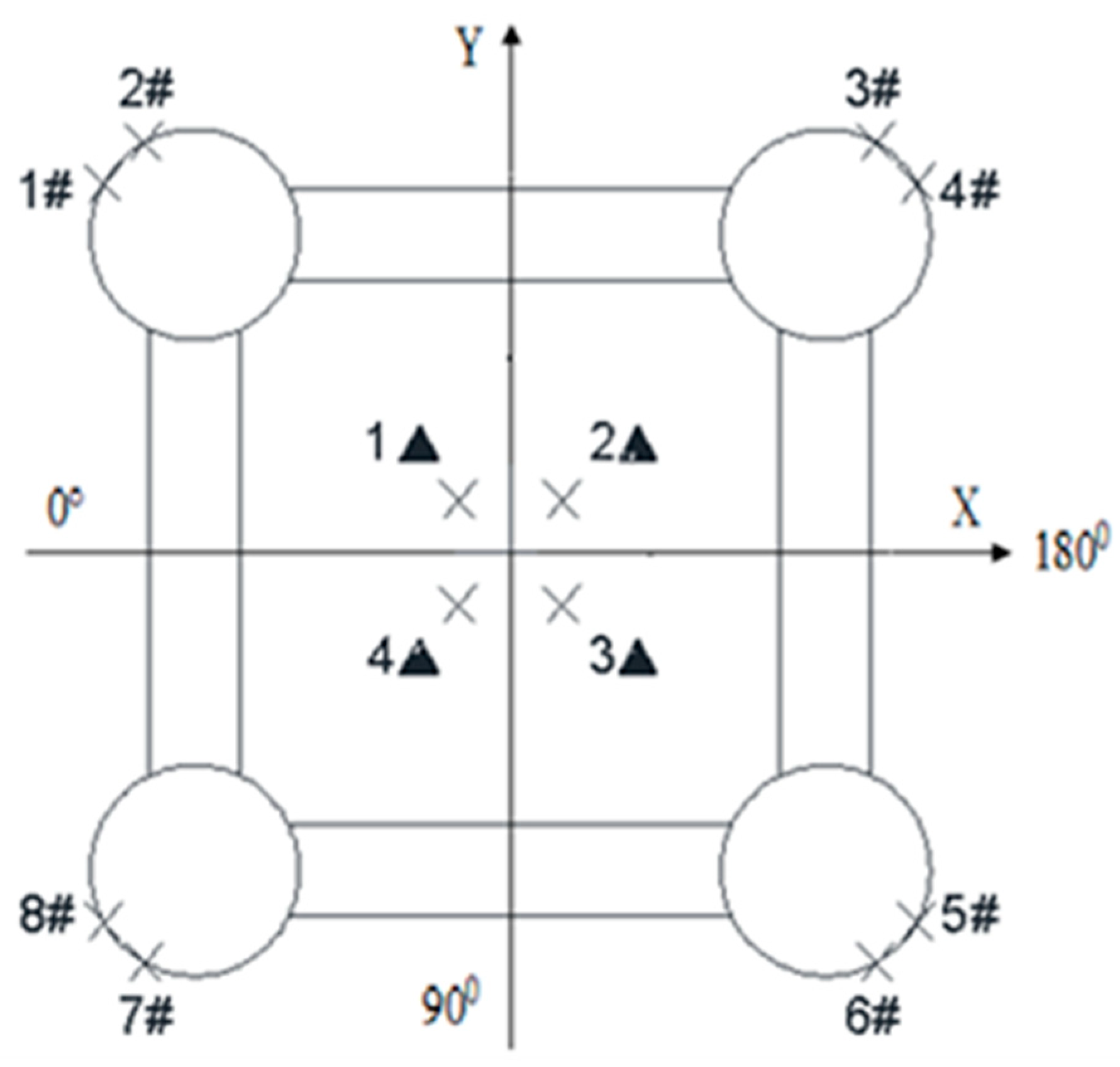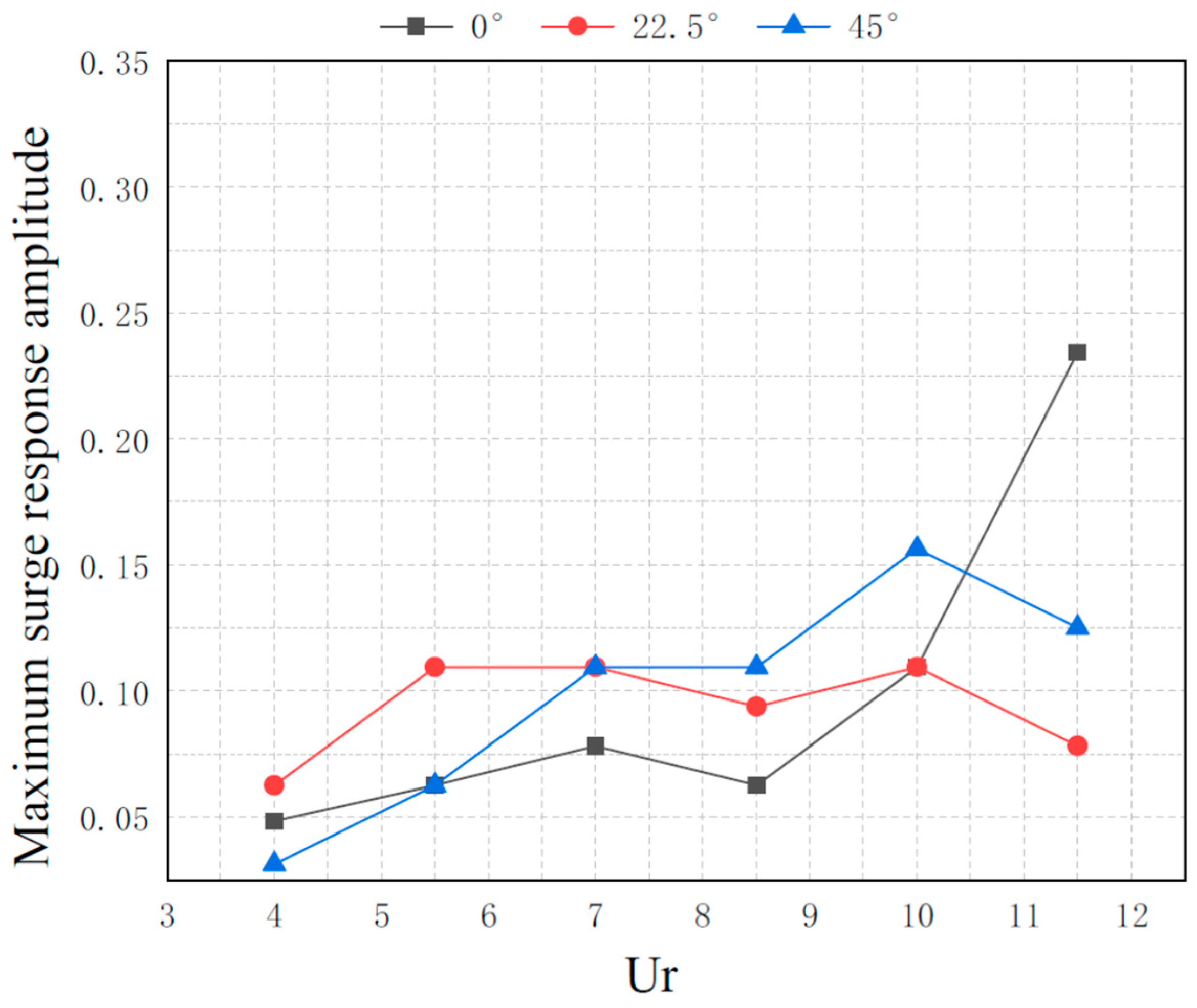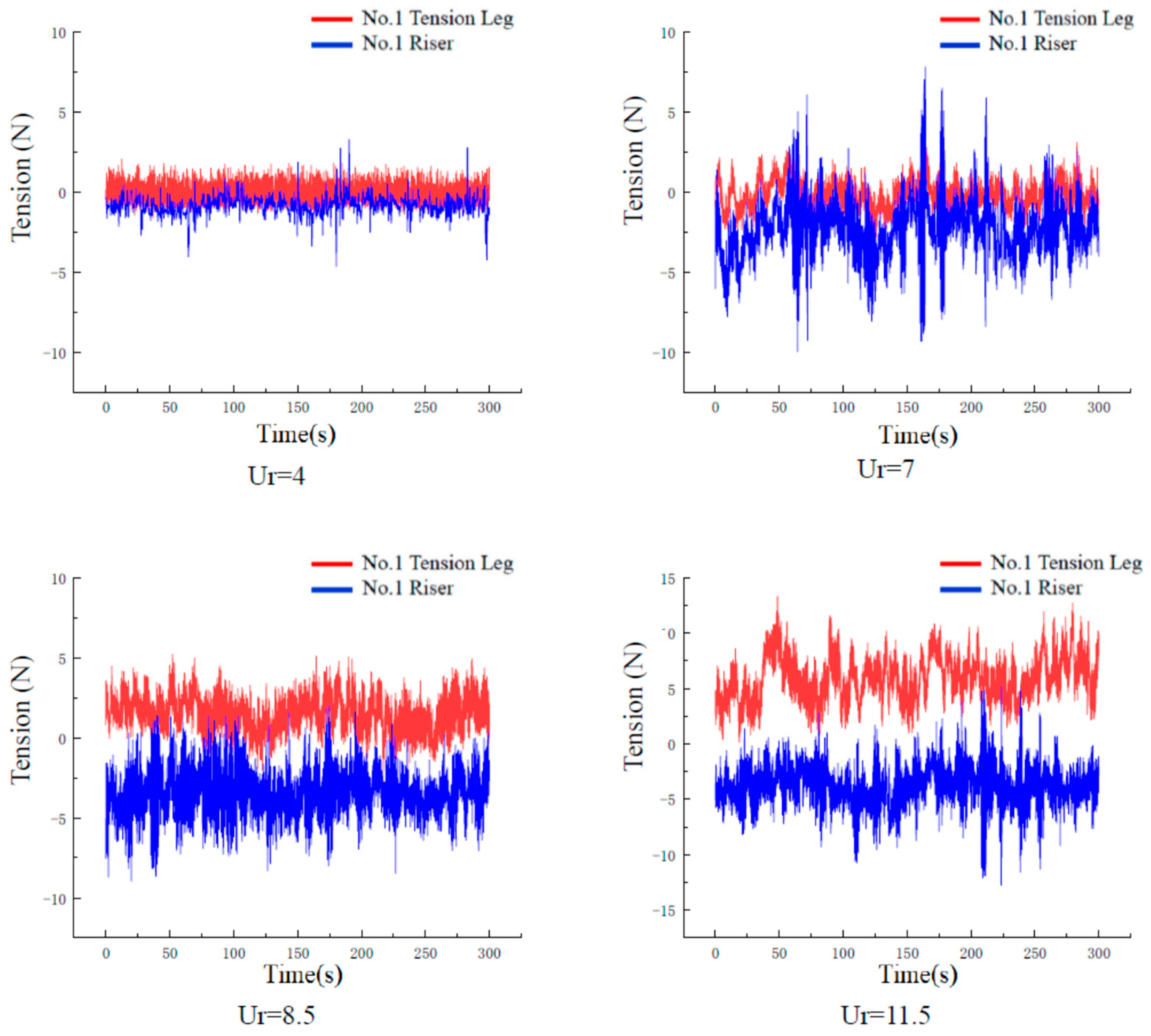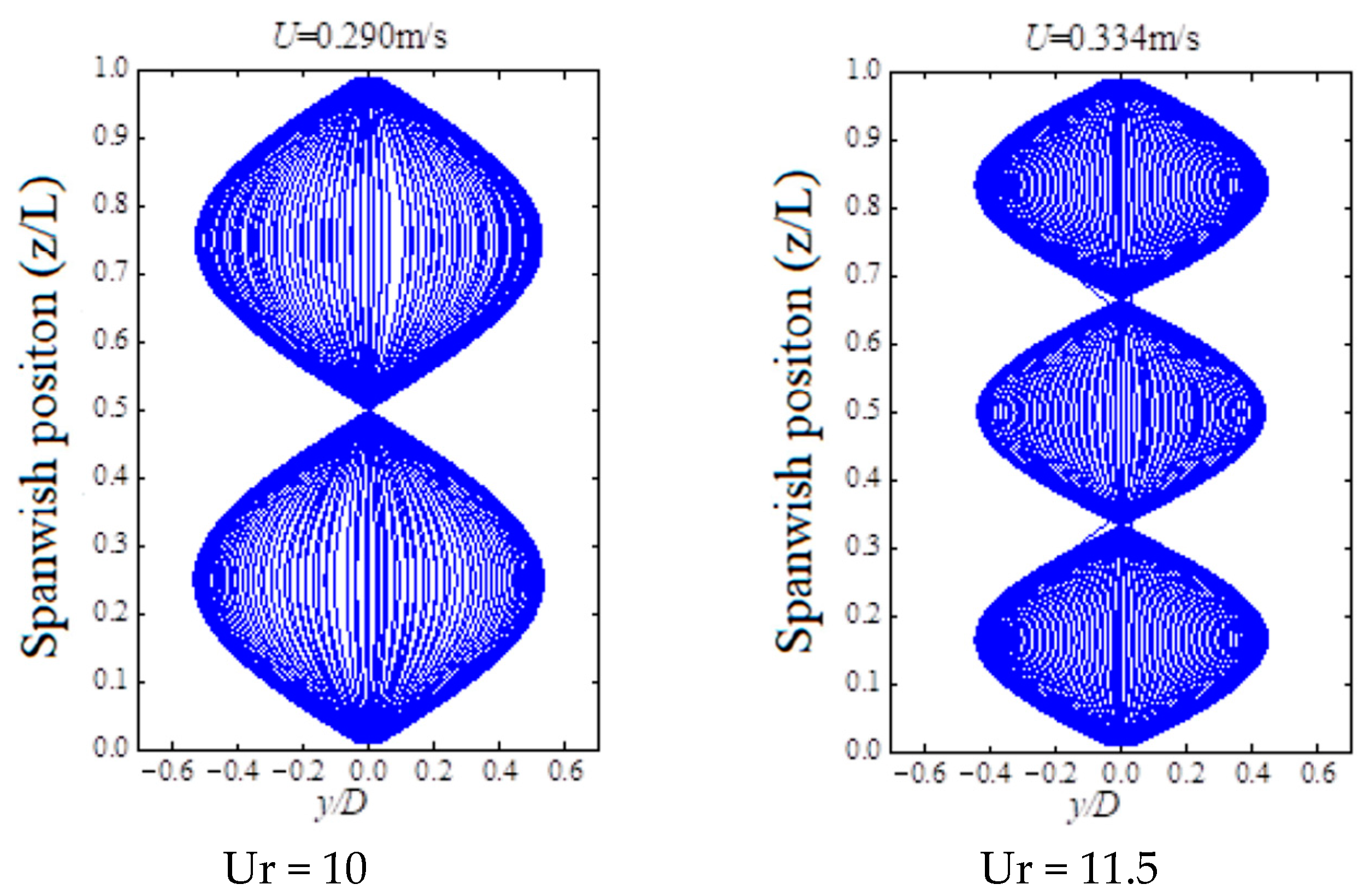Experimental Study on Vortex-Induced Vibration of Tension Leg and Riser for Full Depth Mooring Tension Leg Platform
Abstract
:1. Introduction
2. Test Model and Test Conditions
2.1. Test Model and Test Device
2.2. Test Conditions
3. Tension Response Analysis of Tension Leg and Riser under Uniform Flow
3.1. Vortex-Induced Motion Response of Platform Floating Body under Uniform Flow
3.2. Tension Response of Tension Leg and Riser under Uniform Flow
4. Mode and Displacement Response of Tension Leg and Riser
5. Tension Response of Tension Leg and Riser under Combined Action of Wave and Current
6. Conclusions
Author Contributions
Funding
Institutional Review Board Statement
Informed Consent Statement
Data Availability Statement
Conflicts of Interest
References
- Liu, G.; Li, H.; Qiu, Z.; Leng, D.; Li, Z.; Li, W. A mini review of recent progress on vortex-induced vibrations of marine risers. Ocean Eng. 2020, 195, 106704. [Google Scholar] [CrossRef]
- Wan, D.; Duan, M. Research progress of numerical analysis methods for vortex induced vibration of deep-sea slender flexible risers. Mech. Q. 2017, 38, 179–196. [Google Scholar]
- Huang, X.; Zhang, H.; Wang, X. Research Status, Hotspots and Prospects of Vortex Induced Vibration in Marine Risers. Oceanogr. Res. 2009, 27, 94–101. [Google Scholar]
- Yin, B.; Hu, Q.; Li, Y.; Wang, W.; Zhu, J.; Wang, D. Review of Research on Vortex Induced Vibration Characteristics of Marine Risers. Ship Mech. 2022, 26, 1097–1109. [Google Scholar]
- Chen, W.; Zheng, Z.; Guo, S. Influence of sway motion of floating platform on vortex induced vibration of underwater flexible riser. Offshore Eng. 2014, 32, 8–13. [Google Scholar]
- Song, L.; Fu, S.; Ren, T.; Yu, D.; Zhang, M. Research on vortex induced vibration response and vortex induced force load characteristics of flexible riser under uniform flow. Ship Dyn. 2017, 36, 14–21. [Google Scholar]
- Gao, Y.; Ren, T.; Fu, S.; Xiong, Y.; Zhao, Y. Experimental study on vortex induced vibration response characteristics of flexible riser. Vib. Impact 2015, 34, 6–11. [Google Scholar]
- Gao, Y.; Liu, L.; Fu, S.; Zong, Z.; Zou, L. Study on the trajectory characteristics of vortex induced vibration response of flexible risers. Ship Mech. 2017, 21, 563–574. [Google Scholar]
- Kurushina, V.; Pavlovskaia, E.; Wiercigroch, M. VIV of flexible structures in 2D uniform flow. Int. J. Eng. Sci. 2020, 150, 103211. [Google Scholar] [CrossRef]
- Ulveseter, J.V.; Thorsen, M.J.; Larsen, C.M. Time domain simulation of riser VIV in current and irregular waves. Mar. Struct. 2018, 60, 241–260. [Google Scholar] [CrossRef]












| Parameter | Real Value | Model Value |
|---|---|---|
| Column diameter/m | 19.5 | 0.320 |
| Pontoon height/width/m | 8.5/8.5 | 0.139/0.139 |
| Column center distance/m | 59 | 0.976 |
| Draft/depth/m | 30.5/404.7 | 0.500 |
| Displacement/KG | 49,235,000 | 211.622 |
| Weight/KG | 31,847,000 | 136.885 |
| Height of gravity center/m | 43.16 | 0.708 |
| Test Conditions | Sway Amplitude/(m) | Surge Amplitude/(m) |
|---|---|---|
| Wave current combination | 2.570 | 15.024 |
| Uniform flow | 4 | 14.462 |
Disclaimer/Publisher’s Note: The statements, opinions and data contained in all publications are solely those of the individual author(s) and contributor(s) and not of MDPI and/or the editor(s). MDPI and/or the editor(s) disclaim responsibility for any injury to people or property resulting from any ideas, methods, instructions or products referred to in the content. |
© 2023 by the authors. Licensee MDPI, Basel, Switzerland. This article is an open access article distributed under the terms and conditions of the Creative Commons Attribution (CC BY) license (https://creativecommons.org/licenses/by/4.0/).
Share and Cite
Zhou, W.; Duan, M.; Chen, R.; Qiu, H.; Li, H.; Wang, S.; Wang, Y. Experimental Study on Vortex-Induced Vibration of Tension Leg and Riser for Full Depth Mooring Tension Leg Platform. J. Mar. Sci. Eng. 2023, 11, 180. https://doi.org/10.3390/jmse11010180
Zhou W, Duan M, Chen R, Qiu H, Li H, Wang S, Wang Y. Experimental Study on Vortex-Induced Vibration of Tension Leg and Riser for Full Depth Mooring Tension Leg Platform. Journal of Marine Science and Engineering. 2023; 11(1):180. https://doi.org/10.3390/jmse11010180
Chicago/Turabian StyleZhou, Weiwei, Menglan Duan, Rongqi Chen, Huixian Qiu, Huiming Li, Shisheng Wang, and Yi Wang. 2023. "Experimental Study on Vortex-Induced Vibration of Tension Leg and Riser for Full Depth Mooring Tension Leg Platform" Journal of Marine Science and Engineering 11, no. 1: 180. https://doi.org/10.3390/jmse11010180




